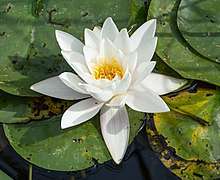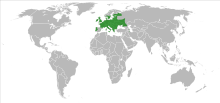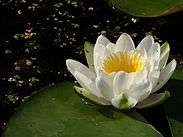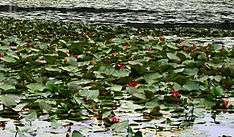Nymphaea alba
Nymphaea alba, also known as the European white water lily, white water rose or white nenuphar, is an aquatic flowering plant of the family Nymphaeaceae.[3] It is native to North Africa, temperate Asia, Europe and Tropical Asia (India).[4]
| European white water lily | |
|---|---|
 | |
| Scientific classification | |
| Kingdom: | Plantae |
| Clade: | Tracheophytes |
| Clade: | Angiosperms |
| Order: | Nymphaeales |
| Family: | Nymphaeaceae |
| Genus: | Nymphaea |
| Species: | N. alba |
| Binomial name | |
| Nymphaea alba | |
 | |
| Synonyms | |
| |
Description
It grows in water that is 30–150 cm (12–59 in) deep and likes large ponds and lakes.
The leaves can be up to 30 cm (12 in) in diameter and take up a spread of 150 cm (59 in) per plant.[3] The flowers are white and they have many small stamens inside.[5]
Taxonomy
It was first published and described by Carl Linnaeus in his book 'Species Plantarum', on page 510 in 1753.[4][6]
The red variety (Nymphaea alba f. rosea) is cultivated from lake Fagertärn ("Fair tarn") in the forest of Tiveden, Sweden, where they were discovered in the early 19th century. The discovery led to a large-scale exploitation which nearly made it extinct in the wild before it was protected.[7]
Nymphaea candida J. Presl is sometimes considered a subspecies of N. alba (N. alba L. subsp. candida (J. Presl) Korsh.).[5]
Distribution and habitat
They are found all over Europe and in parts of North Africa and the Middle East in fresh water.[5] In Africa, it is found in Algeria, Morocco and Tunisia. In temperate Asia, Armenia, Azerbaijan, Siberia, Iran, Iraq, Israel and Turkey. It is found in tropical Asia, within the Indian provinces of Jammu and Kashmir. Lastly, within Europe, it is found in Belarus, Estonia, Latvia, Lithuania, Moldova, Russian Federation, Ukraine Austria, Belgium, Czech Republic, Germany, Hungary, Netherlands, Poland, Slovakia, Switzerland, Denmark, Finland, Ireland, Norway, Sweden, United Kingdom, Albania, Bosnia and Herzegovina, Bulgaria, Croatia, Greece, Italy, Montenegro, North Macedonia, Romania, Serbia, Slovenia, France, Portugal and Spain.[4]
Phytochemistry
It contains the active alkaloids nupharine and nymphaeine, and is a sedative and an aphrodisiac/anaphrodisiac depending on sources. Although roots and stalks are used in traditional herbal medicine along with the flower, the petals and other flower parts are the most potent. Alcohol can be used to extract the active alkaloids, and it also boosts the sedative effects. The root of the plant was used by monks and nuns for hundreds of years as an anaphrodisiac, being crushed and mixed with wine. In the earliest printed medical textbooks, authors maintained this use, though warning against consuming large and frequent doses.[8]
References
- NatureServe (2013). "Nymphaea alba". IUCN Red List of Threatened Species. 2013. Retrieved 30 January 2015.CS1 maint: ref=harv (link)
- "Nymphaea alba L. is an accepted name". theplantlist.org. 23 March 2012. Retrieved 23 October 2017.
- "White Water Lily (Nymphaea odorata)". www.dnr.state.mn.us. Minnesota Department of Natural Resources. Retrieved 18 August 2015.
- "Taxon: Nymphaea alba L." Retrieved 23 October 2017.
- Anderberg, Anders (1996). "Vit näckros". www.linnaeus.nrm.se (in Swedish). Swedish Museum of Natural History. Retrieved 18 August 2015.
- "Nymphaeaceae Nymphaea alba L." .pni.org. Retrieved 23 October 2017.
- Wallsten, Maud; Thorson, Jan; Werlemark, Gun (2005). "Härstammar Claude Monets röda näckrosor från Fagertärn i Närke?" [Are Claude Monet's red water lilies derived from Fagertärn in Närke?] (PDF). Svensk Botanisk Tidskrift (in Swedish) (99:3–4): 146–153. Archived from the original (PDF) on 4 March 2016. Retrieved 18 August 2015.
- Nielsen (1979). Giftplanter [Poisonous plants]. Gyldendals grønne håndbøger (in Norwegian). Cappelen. pp. 68–69. ISBN 8701318411.
| Wikimedia Commons has media related to Nymphaea alba. |


